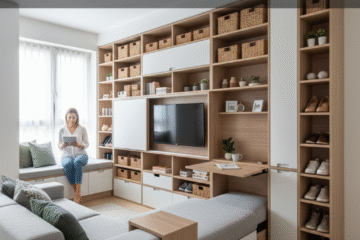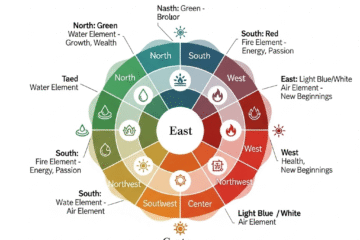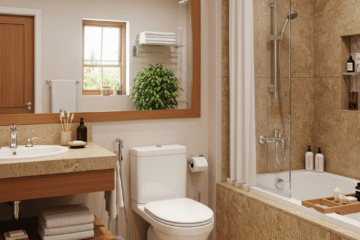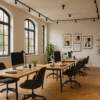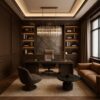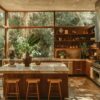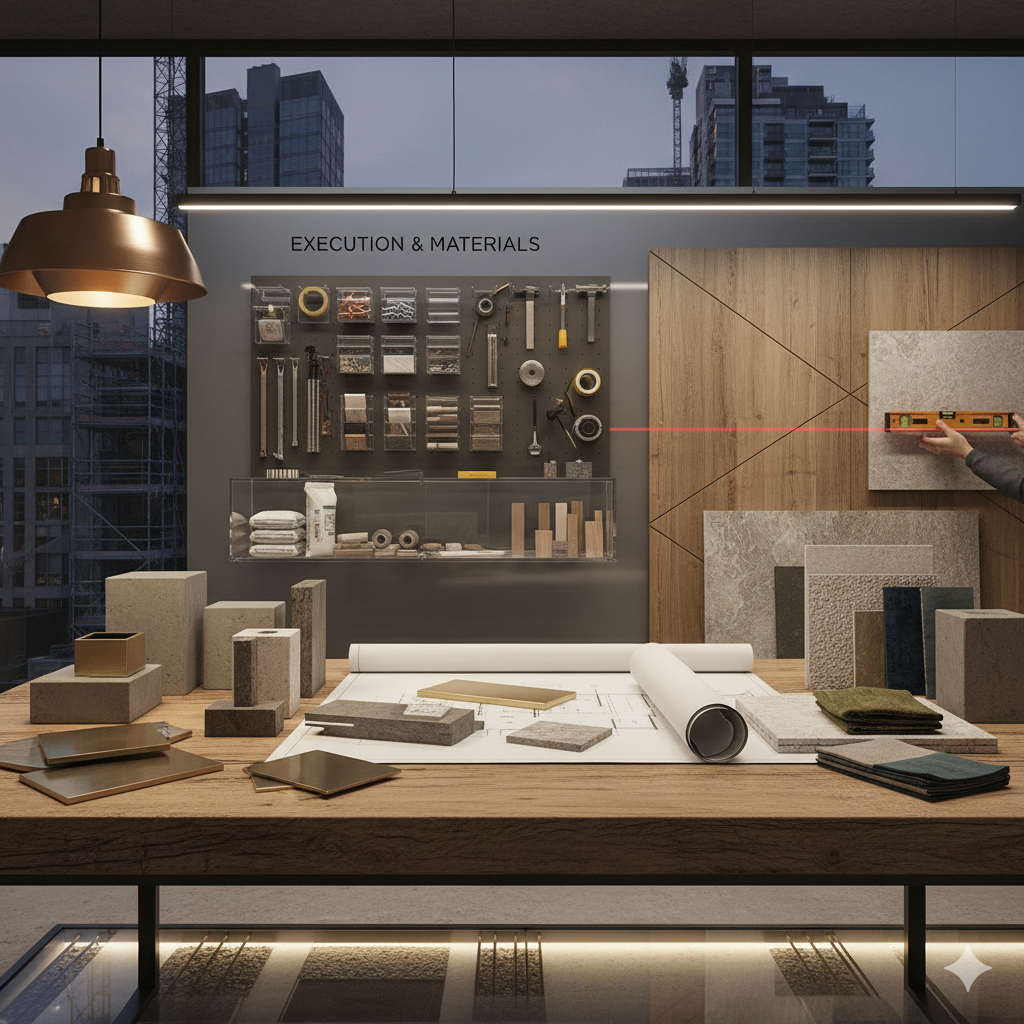
Execution & Materials: Complete Guide to Modern Home Interiors
Execution & Materials form the backbone of any interior design project. While aesthetics and style are important, the materials you choose and the way your interior is executed directly influence durability, functionality, and cost. Understanding the intricacies of Execution & Materials allows homeowners to make informed decisions, create efficient layouts, and achieve the desired look while staying within budget.
Table of Contents
Execution & Materials encompass
Execution & Materials encompass everything from structural finishes, furniture selection, hardware and fittings, flooring, lighting, wall treatments, and ceiling designs. A deep understanding of these elements ensures that the interiors are not only visually appealing but also long-lasting.
One of the most critical decisions in Execution & Materials is the choice of furniture. Homeowners today are presented with modular and custom furniture options. Modular furniture is factory-made, cost-effective, and quick to install. It comes in standardized sizes with pre-designed finishes, making it an ideal choice for small urban homes. Custom furniture, on the other hand, offers complete design freedom and flexibility. It is crafted by carpenters according to the exact dimensions and personal style preferences. While modular furniture is suitable for tight timelines and budget-conscious projects, custom furniture can create unique statement pieces tailored to the home.
Need expert guidance on choosing the best Execution & Materials for your home?
Connect with InteriorGrid.com professionals today.
Materials form the foundation of any successful interior project, directly influencing both execution quality and long-term performance. The finishes applied to furniture, cabinets, and wardrobes not only define aesthetics but also ensure durability. Among the most popular finishes in modern interiors are PU (Polyurethane) and Acrylic.
PU (Polyurethane) finish is valued for its smooth texture and versatility. It can be customized into glossy or matte variations, making it suitable for a range of design themes from sleek modern to understated elegance. Its strong resistance to scratches, stains, and moisture makes PU an excellent choice for high-end modular furniture, including kitchen cabinets, wardrobes, and storage units. Beyond durability, PU enhances the luxurious appeal of interiors by creating a seamless, premium look.
Acrylic finish, on the other hand, is widely preferred for its high-gloss, mirror-like sheen. It delivers a polished and contemporary appearance that instantly brightens up spaces. Acrylic finishes are often used for wardrobes, kitchen shutters, and cabinetry, as they add depth and reflectivity to interiors. Their non-toxic, UV-resistant, and easy-to-clean nature makes them both practical and stylish. When choosing between PU and acrylic, factors such as budget, design preference, and usage intensity play a crucial role. PU leans toward durability and customization, while acrylic is ideal for those prioritizing a sleek, ultra-modern look.
Hardware and Fittings
Beyond finishes, hardware and fittings are equally essential to successful Execution & Materials. They may appear as small details, but they are the components that ensure furniture and installations function seamlessly. Handles, hinges, drawer sliders, knobs, and faucets contribute significantly to both usability and aesthetics.
Modern hardware trends prioritize functionality with sophistication. For instance, soft-close hinges and drawer systems prevent slamming, extending the lifespan of furniture and enhancing user experience. Similarly, push-to-open mechanisms create a handle-free, minimalist look that complements contemporary interiors. For kitchens and wardrobes, high-grade stainless steel fittings and rust-proof hardware ensure longevity and resistance to wear and tear.
Choosing poor-quality fittings may initially reduce costs, but it often leads to frequent repairs, compromised functionality, and higher maintenance expenses in the long run. On the other hand, investing in premium-quality hardware guarantees smooth operation, enhances the overall feel of furniture, and adds a subtle sense of luxury to interiors.
In short, both materials and hardware play an interdependent role in defining the success of an interior project. While finishes like PU and acrylic determine visual impact and durability, fittings and hardware ensure practical usability and long-term reliability. Together, they form the backbone of Execution & Materials, shaping homes that are not only beautiful but also efficient and enduring.
Countertops and finishes
Countertops and finishes are vital in kitchens and bathrooms. Materials like quartz, granite, marble, and laminates are commonly used. Quartz countertops are popular due to their non-porous nature, low maintenance, and wide color variety. Granite offers a natural, textured look, while laminates provide an affordable alternative with ample design choices. For bathrooms, ceramic tiles, vitrified tiles, and engineered stones are commonly preferred for their water resistance and longevity.
False ceilings are another key element in Execution & Materials. False ceilings not only conceal wires and ducts but also enhance aesthetics. Options include gypsum boards, POP (Plaster of Paris), PVC panels, and wooden panels. Gypsum boards are widely used for their smooth finish and flexibility in design, while wooden panels add warmth and elegance. POP ceilings allow creative molding and designs, giving homes a luxurious feel without the high cost of marble or stone.
Flooring choices significantly influence both appearance and maintenance. Vitrified tiles, laminate flooring, engineered wood, and marble are commonly used. Vitrified tiles are popular in modern urban homes due to affordability and durability. Laminate and engineered wood bring warmth and a natural feel, while marble adds timeless elegance but at a higher cost. For compact spaces, using consistent flooring across rooms can create a sense of continuity and make the home feel more spacious.
Lighting systems are essential in Execution & Materials. Layered lighting is the latest trend, combining ambient, task, and accent lights. LED strips, pendant lights, chandeliers, recessed lights, and floor lamps are strategically used to highlight key areas and enhance mood. Smart lighting solutions with dimmers and sensors are gaining popularity for energy efficiency and convenience. Proper lighting selection ensures both functionality and aesthetics are optimized.
Wall treatments are another important area. From textured paints to wallpapers, wooden panels, stone cladding, and decorative laminates, options are endless. Modern Execution & Materials trends focus on eco-friendly paints, sustainable materials, and creative applications like 3D wall panels. Accent walls using bold textures or colors can elevate spaces without extensive renovation costs.
Doors and windows are often overlooked in Execution & Materials but play a crucial role in ventilation, lighting, and insulation. Materials like UPVC, aluminum, and treated wood offer durability and low maintenance. Glass panels, sliding doors, and partition walls can create open, airy spaces while maintaining privacy where needed.
Modular kitchens and wardrobes
Modular Kitchens and Wardrobes in Execution & Materials Planning – Modular kitchens and wardrobes are key to modern interiors. Modular kitchens feature pre-fabricated units for storage, cooking, and appliances, offering functionality, quick installation, and easy maintenance. Modular wardrobes provide space-saving sliding doors, pull-out drawers, built-in organizers, and integrated lighting. These systems optimize space, enhance usability, and add a sleek, contemporary look, making them essential in modern Execution & Materials planning.
Safety and ergonomics are equally vital in Execution & Materials, reflecting the growing demand for practical, family-friendly interiors. From anti-slip tiles in bathrooms that reduce accident risks to furniture designed with rounded edges to avoid injuries, every detail is carefully considered. Childproof cabinets and secure storage units ensure safety for families with children, while proper ventilation systems promote a healthier living environment. Materials are increasingly being selected not only for their visual appeal but also for their durability and role in creating a safe, comfortable, and ergonomic home.
Sustainability in Execution & Materials is rapidly shaping the future of interiors. Homeowners are becoming conscious of their environmental footprint, opting for bamboo and reclaimed wood over conventional materials, low-VOC paints for healthier indoor air, and eco-friendly laminates that reduce environmental impact. Energy-efficient solutions such as LED lighting, water-saving fixtures, and solar-integrated systems are also gaining popularity, blending modern technology with responsible living. These sustainable practices reduce long-term maintenance costs, enhance durability, and contribute to eco-conscious lifestyles.
In essence, Execution & Materials in modern interiors go far beyond aesthetics. They combine modular convenience, safety and ergonomics, and sustainable practices to deliver spaces that are functional, stylish, safe, and future-ready. Every choice, from flooring to lighting, contributes to creating a balanced home environment that supports modern lifestyles while standing the test of time.
Cost management in Execution & Materials
Effective Cost Management in Execution & Materials is a critical aspect of interior projects, ensuring that quality, functionality, and aesthetics are achieved without overspending. It involves strategically planning, monitoring, and controlling costs throughout every stage of execution—from material procurement to labor and installation.
Budget Planning and Allocation
The first step in Cost Management in Execution & Materials is establishing a clear budget. This includes allocating funds for flooring, cabinetry, modular kitchens, wardrobes, lighting, finishes, and décor. Proper allocation prevents unnecessary expenses and allows designers and homeowners to prioritize high-impact areas. A detailed budget ensures transparency and forms the foundation for disciplined cost control.
Material Selection and Procurement
Choosing the right materials is essential in Cost Management in Execution & Materials. Selecting durable yet cost-effective materials—such as laminates instead of solid wood, engineered stone instead of natural granite, or eco-friendly paints—balances quality with affordability. Bulk purchases, vendor negotiations, and local sourcing can further reduce costs without compromising design intent.
Vendor and Contractor Management
A key component of Cost Management in Execution & Materials is managing vendors and contractors efficiently. Clear communication about timelines, specifications, and payment terms prevents cost overruns. Engaging reliable professionals ensures quality workmanship, reducing the risk of rework or material wastage, which can significantly affect project costs.
Monitoring and Controlling Expenses
During execution, continuous monitoring is essential for Cost Management in Execution & Materials. Tracking spending against the initial budget, documenting invoices, and reviewing change orders prevent overspending. Using project management tools and dashboards helps designers and homeowners identify potential cost deviations early and take corrective action.
Optimizing Labor and Installation Costs
Labor and installation contribute significantly to overall project expenses. Cost Management in Execution & Materials involves scheduling work efficiently, avoiding idle time, and combining tasks where possible. Pre-fabricated solutions like modular kitchens and wardrobes reduce installation time and labor costs while maintaining high standards.
Value Engineering
Value engineering is an important strategy in Cost Management in Execution & Materials. By assessing alternatives for materials, finishes, and construction methods, homeowners and designers can achieve similar aesthetics and functionality at lower costs. This ensures that the project remains within budget without sacrificing quality.
Final Inspection and Quality Assurance
The last step in Cost Management in Execution & Materials is quality control and final inspection. Ensuring that all work is completed as per specifications prevents future repairs or replacements, which could add unexpected costs. A thorough handover and snag removal process solidifies the cost-efficiency of the entire project.
Benefits of Effective Cost Management in Execution & Materials
- Prevents Overspending – Adheres to allocated budgets and reduces impulse expenses.
- Optimizes Material Usage – Reduces wastage and ensures efficient procurement.
- Improves Planning Accuracy – Enhances resource allocation for labor and materials.
- Ensures Quality Without Compromise – Maintains standards while controlling costs.
- Streamlines Project Execution – Reduces delays, rework, and unexpected expenditures.
By implementing cost management in execution and materials, interior projects achieve a balanced approach that combines quality, aesthetics, and efficiency. Proper budgeting, material selection, vendor coordination, and ongoing monitoring ensure that homes are stylish, functional, and delivered within budget, making cost management a cornerstone of successful interior design execution.
Cost management in Execution & Materials is another critical aspect. Knowing the price range of materials, labor, fittings, and finishes allows homeowners to make informed choices without exceeding the budget. For example, balancing the use of high-end PU cabinets in visible areas with laminates or MDF units in less visible zones can achieve luxury within budget.
Project planning forms the backbone of any successful interior design journey. A well-thought-out plan ensures smooth execution, minimizes risks, and optimizes both cost and time. Key aspects include defining timelines, selecting the right vendors, conducting routine quality checks, and sourcing high-grade materials. Each stage of Execution & Materials plays a crucial role in determining the final outcome of the interiors. Many homeowners today prefer to engage professional interior consultants who take charge of the entire process, from procurement to installation, to guarantee that everything aligns with the highest standards of quality and efficiency.
In addition to professional oversight, DIY elements are increasingly becoming part of Execution & Materials. Homeowners are embracing hands-on projects such as painting accent walls, experimenting with laminate applications, creating wall paneling, or installing floating shelves. These small yet impactful DIY additions not only reduce overall project costs but also infuse a personal, emotional connection into the home. The blend of professional execution and personal creativity offers the perfect balance between functionality and individuality.
Technology integration has also revolutionized Execution & Materials. From automated lighting systems and modular kitchen solutions to sensor-based bathroom fixtures and app-controlled appliances, smart technology has become a defining element of modern homes. These innovations not only enhance safety and energy efficiency but also elevate convenience, making daily living more seamless and enjoyable. The future of interiors lies in combining aesthetic appeal with smart functionality, and Execution & Materials provide the framework for this transformation.
Ultimately, understanding Execution & Materials in depth empowers homeowners to make informed, strategic decisions. Every detail matters—whether it’s the choice of flooring, ceiling finishes, wall treatments, or furniture fittings. A focus on sustainability, durability, and timeless design ensures interiors that are not only beautiful but also practical and long-lasting. With meticulous planning, wise material investments, and trend-conscious execution, homeowners can create spaces that reflect their lifestyle, deliver comfort, and stand the test of time.

